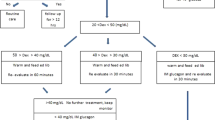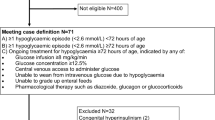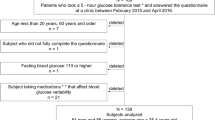Abstract
Extract: Arginine infusions (0.5 g/kg body wt) have been performed in low birth weight infants in order to study the insulin and glucagon control of the glucose homeostasis in the transient hypoglycemia of small for gestational age infants. To evaluate the glucose output by the liver, intramuscular glucagon injection (0.1 mg/kg body wt) was also effected. Twenty-six appropriate for gestational age infants (AGAI) and 29 small for gestational age infants (SGAI), 11 of which were affected by hypoglycemia during the first few days of life, were selected.
In the hypoglycemic SGAI the mean level of glucose in blood showed an evident decrease after arginine, the means being significantly lower at 30 (P < 0.001) and 60 (P < 0.001) min of the test than those of the AGAI and nonhypoglycemic SGAI. The mean levels of insulin in plasma of the nonhypoglycemic SGAI were significantly lower than those of the AGAI during the whole arginine test (P < 0.001 at 0 min, P < 0.05 at 30 min, P < 0.01 at 60 min); however, when the hypoglycemic SGAI were compared with the AGAI such differences no longer existed.
The mean levels of glucagon in plasma were high at fasting and showed a significant (P < 0.05) increase after the arginine infusion without any difference among the means of the three groups of infants at any time of the test. The mean insulin to glucagon molar ratio (ratio between the simultaneous molar concentrations of insulin and glucagon in plasma) was relatively reduced in comparison with the values reported in the adult and did not show any significant variation after arginine, nor was there any significant difference among the three groups of infants at any time of the test.
After glucagon injection an increase of the blood glucose values was observed in AGAI and nonhypoglycemic SGAI, without any significant difference of the means. In the hypoglycemic SGAI the mean levels of glucose in blood throughout the test were lower than those of the other two groups of neonates, but their mean increase on the basal level did not differ significantly from that of the control subjects.
These results offer evidence to exclude an impairment of the modulation of the bihormonal pancreatic secretion as an important factor of the hypoglycemia of low birth weight infants and to confirm the inability of hepatic response to glycogenolytic stimuli.
Speculation: During intravenous arginine infusion the mean values of the insulin to glucagon molar ratio in plasma of hypoglycemic SGAI infants did not differ significantly from those of control infants. The insulin to glucagon molar ratio could indicate, more than the examination of the single hormones, that in SGAI affected by transient hypoglycemia the deficiency of the glucose homeostasis is not correlated with an impairment of the endocrine pancreatic activity.
It is likely that the liver of such infants has a greater sensitivity to glycogenosynthetic than to glycogenolytic stimuli.
Similar content being viewed by others
Log in or create a free account to read this content
Gain free access to this article, as well as selected content from this journal and more on nature.com
or
Author information
Authors and Affiliations
Rights and permissions
About this article
Cite this article
Falorni, A., Massi-benedetti, F., Gallo, S. et al. Levels of Glucose in Blood and Insulin in Plasma and Glucagon Response to Arginine Infusion in Low Birth Weight Infants. Pediatr Res 9, 55–60 (1975). https://doi.org/10.1203/00006450-197501000-00011
Issue date:
DOI: https://doi.org/10.1203/00006450-197501000-00011
Keywords
This article is cited by
-
Blood glucose, plasma insulin and glucagon response to arginine in infants during the first month of life
Journal of Endocrinological Investigation (1980)
-
Insulin and glucagon secretion in the ketotic (idiopathic glucagon unresponsive) hypoglycemia of childhood
Journal of Endocrinological Investigation (1979)
-
Pancreatic endocrine response to the first feed in term newborn infants
European Journal of Pediatrics (1979)



